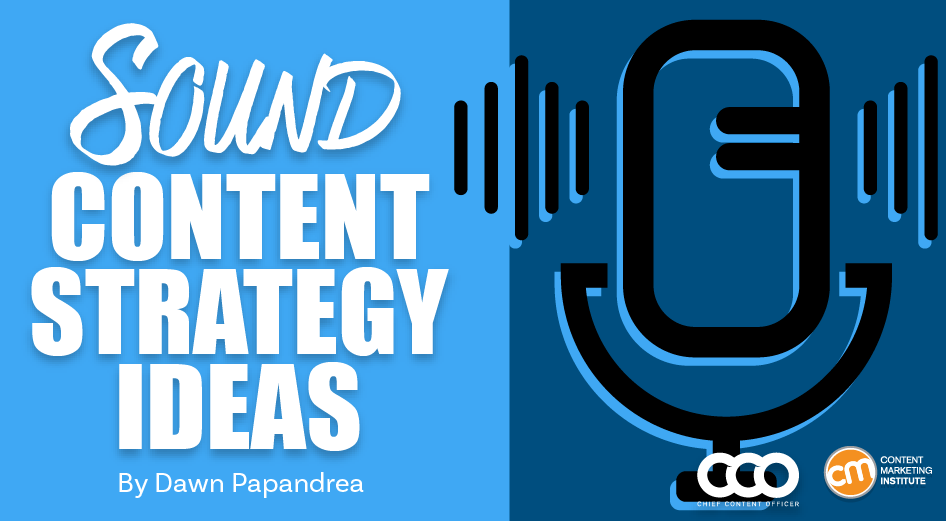
Have you heard?
Listener-friendly content formats like podcasts, audiobooks, and sound snippets enhance the emotional appeal of your stories and strengthen marketing performance.
Think about it. How often do you get your audience’s full attention?
“During your workday, you’re getting pitched and pinged on your devices while you’re in ‘deflect and move on mode,’” says Jeanniey Walden, CMO of Rite Aid and host of the popular Liftoff Journeys podcast.
“But when listening to audio, whether a podcast or an audiobook, you are most likely in a transitionary or relaxed state. At that point, it’s just you and the content.”
You’ll need to develop a strategy to rise above the noise of a crowded content marketplace and set realistic expectations of the value audio can contribute.
Here are some expert perspectives and advice for building content and marketing strategies that include podcasting, sonic branding, and sound snippets.
How to decide whether to launch a brand podcast
According to EMARKETER’s June 2024 industry forecast, U.S. podcast listeners will tune in for an average of 50 minutes daily.
“Humans tend to love to multitask, and audio is the most passive way to learn and consume content,” says A. Lee Judge, co-founder and CMO of audio and video production agency Content Monsta. “You can listen to the podcast while walking or doing daily chores.”
And you can repurpose podcast assets, which extends your production investment’s value. For example, you can edit a lengthy conversation into short snippets for use on social media. Or you can pull verbal testimonials from the show transcript for reuse on websites and in marketing campaigns.
“The podcast is not the end product. The podcast is a source of content,” Lee says.
Still, a podcast may not be an ideal fit for every marketing goal.
“If you have an existing but passive audience or a singular premise you wish to own publicly (similar to what a book can do for you), then you may want to launch a show,” says Jay Acunzo, host of the How Stories Happen podcast and co-founder of Creator Kitchen.
On the other hand, a podcast may be a poor choice if audience growth is your primary goal. “The podcast itself doesn’t spread like other forms of content. The host must go out and promote the show, like an actor with a film or author with a book,” Jay says.
To create a successful show, Jay recommends investing in these critical elements:
- A well-developed, perspective-conveying premise
- An irresistible format that gets people to stick around through the end of the episode
- Trustworthy, entertaining talent
Just don’t expect to compete with celebrity podcasters like Steven Bartlett or Anna Faris.
Lee Judge explains, “If you’re selling industrial door hinges, your entire market may only be 100,000 people.”
When gauging the marketing impact of your podcasts, don’t rely solely on traditional podcast metrics. For example, one of Lee’s clients reported a noticeable increase in inbound inquiries, though her podcast analytics data didn’t reflect this successful outcome.
“If she stuck with what her podcast analytics indicated, she would have thought the show wasn’t working. But when people began telling her, ‘I heard you here. I heard you there.’ She knew it was working,” Lee says.
If you lack the buy-in or budget to host a show, consider pitching company thought leaders as potential guests on other industry podcasts — or sharing your content as a show sponsor.
Should you invest in sonic branding?
When certain sounds or musical triggers make your audience automatically think of your company, that’s sonic branding at work.
“Sonic branding is a system of strategically crafted sound that makes people feel something about a brand or experience,” says John Taite, EVP of global brand partnerships at Made Music Studio. “We often say that people think about what they see, but they feel what they hear.”
There’s real marketing power in an instantly recognizable sound.
“It’s a subconscious memory trigger that kicks in when you’re making a purchase decision — be it a car or a candy bar,” John says. “Every piece of branded sound or music makes a long-term impression on a consumer — from advertising to social content to activations.”
John should know: His company is behind Cricket Wireless’s signature beep, Nature Valley’s “call of the crunch” whistle, and the Cinnamon Toast Crunch “Cinnadust!” sound.
Whether you’re a B2B or B2C brand, large or small, your organization is probably making a sound. But unless it’s deliberate, it’s just noise, says Roscoe Williamson, global creative strategy & innovation director at MassiveMusic, which creates music and soundscapes for brands.
“You would never just have a random logo, random type fonts, or a random visual identity, right? If you’re not thinking about sound in those same terms, you’re missing out [on potential branding advantages],” Roscoe says.
Roscoe cites his team’s work with TikTok as one of his favorite examples of the power of sonic branding:
“TikTok had a problem with off-site brand attribution. When people [shared] a TikTok film to another site, like Instagram or Reddit, research showed that people weren’t attributing that content to TikTok as much as the brand would like,” he explains.
His team created the now ubiquitous sonic logo that appears on any TikTok content pushed off-site — in other words, onto millions of films every week — which is now the signature sound of TikTok.
[embedded content]
Sonic branding includes using sound for social media touchpoints, audio advertising, in-person experiences (like trade shows or in-store shopping), and the product sounds like alerts when a task is complete or an error has been made.
Choosing the right sound palette for your brand starts with creating guardrails for what you do and don’t want to sound like.
“[Those decisions] should align with what your brand stands for — either its values or its tone of voice or promise,” Roscoe says. “Just having that point of view and being consistent will put those brands ahead of others [that] don’t even think about it.”
But, when sonic branding isn’t taken seriously or done right, it can damage consumers’ perception of your brand. “Just ask one of the 15 brands on-air right now using the sound of a doorbell,” says John Taite of Made Music Studio. “You can’t stand out from the clutter when you are the clutter.”
Add audio to existing content
If podcasts and sonic branding initiatives aren’t strategic fits, other approaches are worth exploring. For example, you can use AI automation to efficiently create sound content or incorporate audio features into your existing stories.
Ann Handley, author, speaker, and the world’s first “Chief Content Officer,” sees the ease of working with the latest tech as “an opportunity to use audio to create a fuller, richer customer experience and deeper audience connection.”
Brands can also give their Reels, TikTok videos, and text-based content an audible upgrade with the help of AI-generated audio overlays.
“AI is great at voicing factual information. If I’ve created a blog article, it’s useful to have an AI voice read it just like it’s written because my goal is to [help my audience] consume the facts on the page,” Content Monsta’s Lee Judge says.
Lee says AI can be a good substitute for human talent if you lack sufficient resources. He uses this analogy: “AI is like a stand-in recording. You can enjoy watching recorded music videos, but it isn’t like being at the concert.”
Even so, AI can help in a different way.
“AI can translate audio into different languages and make it available to global populations in ways that it hasn’t been done before,” Rite Aid’s Jeanniey Walden points out.
Let your audience hear your brand voice
As you prepare your strategy, consider turning up the volume to invite people to gather around and listen. Podcasts, sonic logos, and adding music and sound to existing content assets help deepen relationships.
Remember: “Audio is about resonance, not reach,” Jay Acunzo says. “Focus on activating existing audiences and turning them into superfans.”
A version of this article ran in the August 2024 edition of Chief Content Officer.
HANDPICKED RELATED CONTENT:
Cover image by Joseph Kalinowski/Content Marketing Institute



